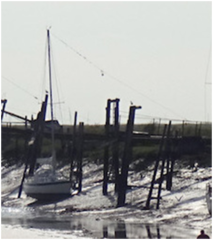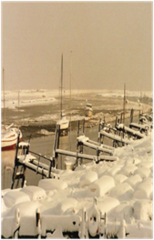Some time back I was chastised by some club friends about the length of my articles. For them I offer a synopsis; not as smart as War and Peace but then I’m not Tolstoy! For those more literate please enjoy the full article.
Synopsis – Equinox, time to move boat onto cradle, M25 traffic bad causing delay, in rush forgot to untie a securing line ashore, used knife to release it, just enough water to get to slipway, success, use a checklist.
It was the autumn equinox and time to put my Folkboat, Othona, onto her shore cradle at Benfleet SC. As always it was only at the weekend that we had free time so, club tractor booked, we left Harpenden on the Saturday morning and proceeded to the M25 and north about to the A127 Southend at J29.
An hour into our journey and ahead we could see flashing warning lights and shortly the brake lights of vehicles. As we slowed to the rear of the queue I wondered what the problem was; no Google maps in those days. More worryingly there was a mere trickle of traffic moving the other way; not good. The minutes moved into half an hour and I began to be concerned about the time left to get to Benfleet before we lost water. As a drying creek we only had 2/2 ½ hours of water either side of high. At last the radio squawked and announced the road news; bad news, a major incident ahead, long delays and the accident was a distance of some eight miles.
Eventually getting to J29 we left the M25 but no sooner than we joined the Southend road than flashing blue lights appeared in the rear mirror and police and ambulances made their way past and we joined yet another slow moving line of traffic. It was a journey from hell and we lost more time despite using side roads to avoid the jams. At last we drove into the club yard. Rushing down to the slip I found the Yard leader of the day and explained what had happened. No problem he said but I needed to get a move on as the tide had turned half an hour ago so just over an hour of water left to get Othona onto the cradle. I dragged out the inflatable dinghy, vigorously pumping air into her. Fully inflated we slipped and jumping in I rowed energetically downstream to Othona where we wasted no time cambering aboard.
Now those in the know will appreciate that starting a Stuart Turner first time on a cold damp day is more an act of faith than practice. So I was very pleasantly surprised when the engine started first time and I left it to warm up as she had a habit of dying if the throttle was used before she was nice and hot. In the meantime I rushed around shortening lines, slipping the springs, adjusting fenders for the cradle, untying the tiller and coiling spare lines ready to throw to the shore party as we approached the slipway. We were ready and I indicated to Chrissy that she should go to the bow ready to slip the bow line. ‘Ok’, I shouted, ‘slip the line’ and, helm over, I moved the throttle forward and eased out into the stream. Almost immediately the boat violently heeled.
Chrissy, standing at the bow, was almost thrown overboard and I fell onto the cockpit sole as Othona leaned to Port and veered toward the bank. My first thought was that the keel had dropped off; not unknown on wood boats with an iron keel held on by old keel bolts! My second thought was the realisation that, somehow, we were still attached to the bank.
As we swung back to the bank I spotted the problem, the line to the masthead was still attached to the shore! To explain. When moored to a steep sided tidal river bank there is a need to ensure the boat does not ‘fall over’, away from the bank, when the tide is out and the bank dries. To achieve this you take a line from the top of the mast and attach it ashore to a large concrete block or heavy iron post buried in the ground. To enable the boat to move with the rise and fall of water this line is long and midway along its length a weight is securely attached, in our case an old lorry tyre. This provides a very effective ‘dampener’ to the line, the mast and the boat. It was this line that in our haste I had forgotten to let go.
So almost without thought, indeed in retrospect it was foolhardy, but I was sprighly then, I leapt ashore, grasping my trusty boat knife and, pirate style, slashed the masthead line. Othona sprang upright and I just managed to scramble back aboard as Othona veered back into the stream and with prop re-engaged we were off again, heart thumping. With no more ado we manoeuvred up to the slipway and slid easily over the cradle adjusting position and lines as the water dropped around us; we were just in time. The tractor driver shouted to us to hold on and pulled the cradle, Othona and us up the slipway and into our allotted place in the yard.
We had made it but I had learnt a lesson; if you are in a hurry, especially if you are in a hurry, check and check again. Mooring lines, electrics, fuel, instruments, gas, stopcocks, hatches, fenders, crew(!)......before leaving any mooring or dock or leaving your boat. As a good friend and ex Concorde pilot said last time he was out with me as I stood checking if I had secured everything before leaving the boat, ‘Murray, use a checklist, pilots use them for a reason’! So, please, if you do not already do so, make and use a checklist; you know it makes sense.
Submitted on 27th April 2022


